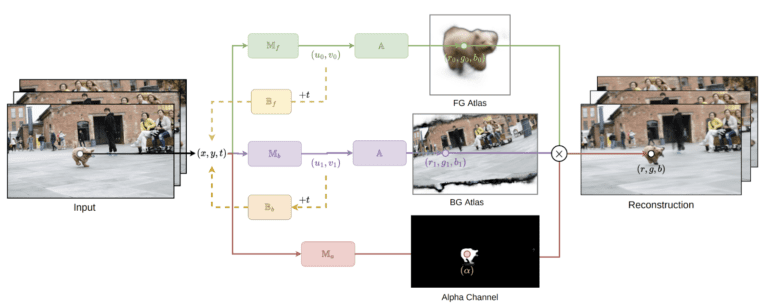TL;DR:
- INVE, the Interactive Neural Video Editor, revolutionizes video editing.
- Image editing flourished, while video editing lagged due to complexity.
- INVE simplifies video edits using layered neural atlas representations.
- Challenges like object movement and frame inconsistencies are addressed.
- Bi-directional mapping enhances editing predictability and options.
- Multi-resolution hash coding accelerates learning and inference.
- INVE empowers users with diverse editing operations for seamless results.
Main AI News:
In a digital age where images reign supreme, can you fathom a cyber realm devoid of image manipulation? The realm where amusing memes, elegant Instagram snapshots, captivating vistas, and more, would have vanished into the void. Such an Internet would be bereft of delight, wouldn’t it?
Since the advent of digital cameras, the art of image editing has kindled a fervor among many. Commencing with rudimentary tools, today’s capability allows for image alchemy, where the transformation of the mundane into the extraordinary is effortlessly realized. The realm of image editing has evolved exponentially, particularly in recent years, and the driving force behind this transformation is the might of AI.
Yet, when we shift our focus to the domain of video editing, we unearth a disparity. Video editing, a domain demanding technical acumen and intricate software, has struggled to keep pace. Navigating through the labyrinthine intricacies of tools like Premier and FinalCut Pro is a requisite, as meticulous adjustments beckon. It’s no wonder that video editing has emerged as a lucratively compensated skill in contemporary times. Contrastingly, image editing finds solace even within mobile applications, its outcomes gratifying the average user.
Now, conceive of a world where interactive video editing mirrors the user-friendly grace of its image editing counterpart. Envision a realm where bidding farewell to technical entanglements ushers in an era of unbridled liberation. Enter INVE.
INVE, the moniker for Interactive Neural Video Editor, emerges as an AI marvel that squarely confronts the challenges of video editing. Its purpose, as its name suggests, is to furnish non-professional users with the means to orchestrate intricate video modifications with unwavering ease.
At the heart of INVE lies a profound objective: to empower users to undertake sophisticated video edits through a conduit of simplicity and intuition. The methodology draws upon layered neural atlas representations, comprising two-dimensional atlases (depicting images) for each object and the backdrop within the video. These atlases confer the power of localized and harmonious edits.
Yet, the realm of video editing is fraught with inherent trials. The undulating motion of distinct objects within video ushers forth the need for pinpoint localization and meticulous composition to obviate the intrusion of unnatural aberrations. Furthermore, the endeavor of editing individual frames teeters perilously close to the precipice of inconsistency and apparent glitches. INVE boldly addresses these quandaries, its gambit resting on a pioneering strategy of layered neural atlas representations.
The crux of this approach involves encapsulating a video as a symphony of two-dimensional atlases: one dedicated to each mobile object and another enfolding the backdrop. This representation engenders the scope for edits that are localized, preserving a tapestry of harmony throughout the video’s fabric. Yet, antecedent methodologies grappled with the challenge of bi-directional mapping, confounding the predictive vista for specific edits. Further compounding the conundrum was the computational labyrinth, impeding the prospect of real-time interactive editing.
Enter INVE, which forges a bidirectional cartography between these atlases and the visual tapestry of the video. This synergy confers users with the authority to wield edits within the atlas or upon the video itself, thus augmenting the arsenal of editing options and deepening the comprehension of how these edits shall manifest in the final opus.
Moreover, the prowess of INVE extends to the adoption of multi-resolution hash coding, an innovation that galvanizes the stride of learning and the tempo of inference. This culminates in an immersive editing experience, wherein users are liberated to revel in the realm of true interactivity.
INVE unfurls a lavish lexicon of editing maneuvers, encompassing the tracking of rigid textures and the finesse of vectorized sketching. It empowers users to materialize their creative visions sans impediment. Even novices can now harness the potency of interactive video editing, unshackled from the fetters of technical intricacies. Video editing metamorphoses into a seamless endeavor: whether it’s grafting external graphics onto a moving automobile, harmonizing the forest’s hues in the background, or sketching upon a traversed path, these alterations elegantly cascade through the entire video tapestry.
Conclusion:
The emergence of INVE signifies a transformative leap in the domain of video editing. While image editing achieved user-friendly accessibility, video editing struggled with technical intricacies. INVE’s integration of layered neural atlas representations and bi-directional mapping surmounts these challenges, enabling effortless, localized edits. This breakthrough not only empowers non-professional users but also augments the market’s potential by democratizing video editing, fostering creativity, and expanding the horizons of interactive content.

